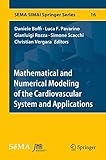Mathematical and Numerical Modeling of the Cardiovascular System and Applications [electronic resource] / edited by Daniele Boffi, Luca F. Pavarino, Gianluigi Rozza, Simone Scacchi, Christian Vergara.
Material type: TextSeries: SEMA SIMAI Springer Series ; 16Publisher: Cham : Springer International Publishing : Imprint: Springer, 2018Edition: 1st ed. 2018Description: XII, 243 p. 97 illus., 64 illus. in color. online resourceContent type: text Media type: computer Carrier type: online resourceISBN: 9783319966496Subject(s): Computer mathematics | Computer science—Mathematics | Bioinformatics | Computational biology | Cardiovascular system | Computational Mathematics and Numerical Analysis | Math Applications in Computer Science | Computer Appl. in Life Sciences | Cardiovascular BiologyDDC classification: 518 LOC classification: QA71-90Online resources: Click here to access online
TextSeries: SEMA SIMAI Springer Series ; 16Publisher: Cham : Springer International Publishing : Imprint: Springer, 2018Edition: 1st ed. 2018Description: XII, 243 p. 97 illus., 64 illus. in color. online resourceContent type: text Media type: computer Carrier type: online resourceISBN: 9783319966496Subject(s): Computer mathematics | Computer science—Mathematics | Bioinformatics | Computational biology | Cardiovascular system | Computational Mathematics and Numerical Analysis | Math Applications in Computer Science | Computer Appl. in Life Sciences | Cardiovascular BiologyDDC classification: 518 LOC classification: QA71-90Online resources: Click here to access online | Item type | Current library | Call number | Status | Date due | Barcode | Item holds |
|---|---|---|---|---|---|---|
 e-Books
e-Books
|
Central Library, Sikkim University | 518 (Browse shelf(Opens below)) | Not for loan | E-3041 |
1 Daniele Boffi, Lucia Gastaldi, and Luca Heltai, A distributed Lagrange formulation of the Finite Element Immersed Boundary Method for fluids interacting with compressible solids -- 2 Jessica Cervi and Raymond J. Spiteri, High-Order Operator-Splitting Methods for the Bidomain and Monodomain Models -- 3 Piero Colli Franzone, Luca F. Pavarino, and Simone Scacchi, Electro-mechanical modeling and simulation of reentry phenomena in the presence of myocardial infarction -- 4 Lorenzo Fassina, Marisa Cornacchione, Maria Evelina Mognaschi, Giovanni Magenes, and Fabio Naro, Ergotropic effect in cardiac tissue after electromagnetic and beta-adrenergic stimulus -- 5 Emilio Macchi, Ezio Musso, and Stefano Rossi, Role of electrotonic current in excitable cells -- 6 Andrea Manzoni, Diana Bonomi, and Alfio Quarteroni, Reduced order modeling for cardiac electrophysiology and mechanics: new methodologies, challenges & perspectives -- 7 Michele Conti, Simone Morganti, Alice Finotello, Rodrigo M. Romarowski, Alessandro Reali, and Ferdinando Auricchio, Aortic Endovascular Surgery -- 8 Marco Tezzele, Francesco Ballarin, and Gianluigi Rozza, Combined parameter and model reduction of cardiovascular problems by means of active subspaces and POD-Galerkin methods -- 9 Christian Vergara and Stefano Zonca, Extended Finite Elements method for fluid-structure interaction with an immersed thick non-linear structure.
The book comprises contributions by some of the most respected scientists in the field of mathematical modeling and numerical simulation of the human cardiocirculatory system. It covers a wide range of topics, from the assimilation of clinical data to the development of mathematical and computational models, including with parameters, as well as their efficient numerical solution, and both in-vivo and in-vitro validation. It also considers applications of relevant clinical interest. This book is intended for graduate students and researchers in the field of bioengineering, applied mathematics, computer, computational and data science, and medicine wishing to become involved in the highly fascinating task of modeling the cardiovascular system.


There are no comments on this title.